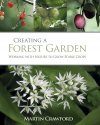Handbook / Manual
By: Martin Crawford(Author), Rob Hopkins(Foreword By)
384 pages, colour photos, b/w line drawings
![Creating a Forest Garden Creating a Forest Garden]()
Click to have a closer look
About this book
Contents
Customer reviews
Biography
Related titles
About this book
Growing food sustainably is becoming more and more important in the light of our changing climate. Forest gardening is a way of working with nature that is not only productive and requires minimal maintenance, but also has great environmental benefits. A forest garden is a managed ecosystem modelled on the stucture of young natural woodland, with a diversity of crops grown in different vertical layers. Unlike in a conventional garden, nature does most of the work for you.
Creating a Forest Garden tells you everything you need to know – whether you want to plant a small area in your back garden or develop a larger plot. It includes advice on planning, design (using permaculture principles), planting and maintenance, and a comprehensive directory of over 450 trees, shrubs, herbaceous perennials, herbs, annuals, root crops and climbers – almost all of them edible and many very unusual.
As well as more conventional plants you can grow your own Nepalese raspberries, chokeberries, goji berries, almonds and hops – while creating a beautiful environment that benefits both you and the ecosystem. Forest gardens offer one solution for a long-term, sustainable way of growing food without compromising soil quality, food quality or biodiversity.
Contents
Foreword by Rob Hopkins
Introduction
Part 1: How forest gardens work
1. Forest gardens
2. Forest garden features and products
3. The effects of climate change
4. Natives and exotics
5. Emulating forest conditions
6. Fertility in forest gardens
Part 2: Designing your forest garden
7. Ground preparation and planting
8. Growing your own plants
9. First design steps
10. Designing wind protection
11. Canopy species
12. Designing the canopy layer
13. Shrub species
14. Designing the shrub layer
15. Herbaceous perennial and ground-cover species
16. Designing the perennial/ground-cover layer
17. Annuals, biennials and climbers
18. Designing with annuals, biennials and climbers
Part 3: Extra design elements and maintenance
19. Clearings
20. Paths
21. Fungi in forest gardens
22. Harvesting and preserving
23. Maintenance
24. Ongoing tasks
Glossary
Appendix 1: Propagation tables
Appendix 2: Trees and shrubs for hedging and fencing
Appendix 3: Plants to attract beneficial insects and bees
Appendix 4: Edible crops by month of use
Resources: Useful organisations, suppliers and publications
Customer Reviews
Biography
Martin Crawford has 25 years experience in horticulture and agriculture. He founded the Agroforestry Research Trust and is currently managing a two-acre forest garden in Dartington in Devon, which he planted 15 years ago.
Handbook / Manual
By: Martin Crawford(Author), Rob Hopkins(Foreword By)
384 pages, colour photos, b/w line drawings
"This book is a magnificiently produced and massive tome that is sure to become every forest gardener's horticultural toolkit and bible."
- Grow It
"Martin has produced a book that is not only visually beautiful but very practical, offering advice on planning, designing, planting and general maintenance."
- Positive News – Summer 2010
"If you are seriously considering the creation or maitenance of a forest garden then you would do well to have this book on your shelves. Even if you are only looking for novel ground cover suggestions in shaded areas or approaches to inter-planting trees, then this book offers bountiful food for thought."
- Green Prophet
"Creating a Forest Garden is a fascniating read for gardeners interested in how to plant communities that work."
- Gardens Illustrated
"Martin Crawford has produced a spectacularly useful guide to new horticultural and ecological terrain of great importance."
- Permaculture Activist
"This semina piece of work is not only visually entralling, it's incredibly easy to use and it contains a level of detail and explanation that makes it, I believe, a must read for anyone who is serious about building a truly sustainable forest."
- WWOOF Ireland
"Martin's book is visually stunning with beautiful photography and illustrations, accompanying very informative and well constructed text."
- Self Sufficient-ish Website – 11 June 2010
"This book is a must if you are interested in producing food from your garden, becoming more self-sufficient or just curious about plants and their uses."
- The Cottage Gardener – June 2011
"The ultimate book on the subject [...] extremely thorough and beautifully illustrated"
- Let's Talk (East Anglia)






























